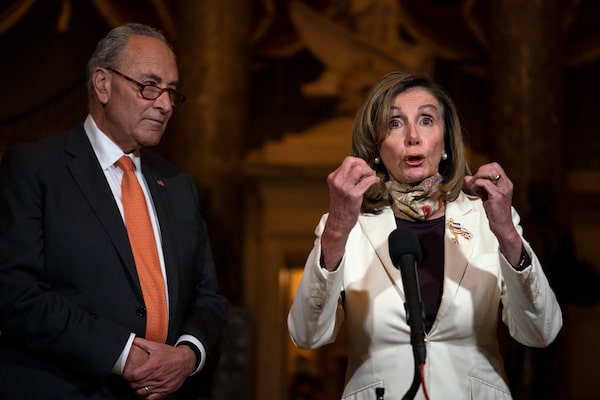WANTED: AUGUST LIFELINE FOR TOURISM

People drive down the Las Vegas Strip during a caravan rally in support of extending the $600 unemployment benefit, on Aug. 6.BRIDGET BENNETT/AFP/Getty Images
August conjures up images of beaches and sunshine, but it may not bring much respite to travel and tourism stocks. Battered by lockdowns, tourism has lagged a broader market recovery, with airline, hotel and leisure shares 20 per cent to 50 per cent lower year-to-date.
After an uptick since the start of August – Europe’s travel and leisure index has risen 7 per cent – the lifting of a U.S. advisory against foreign travel and initiatives, such as Spain’s offer to cover travellers’ health costs, could provide some support.
But more is at stake than share prices – shrinking tourism may shave 3 per cent to 11 per cent off countries’ GDP. And as stricken airlines and hotels lay off staff, mass unemployment is a potent threat.
BUY EVERYTHING!(?)

House Speaker Nancy Pelosi of Calif., joined by Senate Minority Leader Sen. Chuck Schumer of N.Y., speaks to reporters on Capitol Hill in Washington, Thursday, Aug. 6.Carolyn Kaster/The Associated Press
We will soon learn if the “buy everything” trade has legs.
The U.S. Congress’ dithering over approving more stimulus has pushed gold to record highs above US$2,000 while U.S. Treasury yields have lurched lower. But equities are also riding high – clearly the powerful backstop of central bank stimulus is holding firm.
The rush for everything – risk as well as safety – has lingered. But positioning on most markets is stretched and such good news as there is, from earnings to vaccine trials, seems priced in. Forthcoming data, election news plus China-U.S. trade talks might show the difficulties of having one’s cake and eating it.
LOOKING INTO THE FUTURES

In this July 28 file photo, Democratic presidential candidate former Vice President Joe Biden speaks at a campaign event at the William "Hicks" Anderson Community Center in Wilmington, Del.The Associated Press
The U.S. election campaign has yet to have much traction on markets, but that may change soon. Presumptive Democratic nominee Joe Biden will announce a running mate before the Aug. 17 Democratic convention. President Donald Trump meanwhile is intensifying his campaign against mail-in voting, which he says encourages fraud.
Some investors are moving to hedge portfolios against volatility around the Nov. 3 election. That shows up in futures on the Cboe Volatility Index, which shows a bump in expectations for market swings around then.
The implied volatility rise looks especially steep, given the VIX itself has eased to five-month lows. The spread between August and October VIX futures is at 5.5 points, the widest since the contracts began trading.
The focus may be less on the outcome and more on possible delays in tallying results owing to the widespread use of mail ballots this year. Volatility and legal challenges remain risks.
TURKEY’S TIGHTENING TRICKS

A currency exchange office worker counts Turkish Lira banknotes in front of the electronic panel displaying currency exchange rates at an exchange office in Istanbul, on Aug. 6.YASIN AKGUL/AFP/Getty Images
Turkey’s central bank is acting to limit the lira’s plunge, using backdoor tools that bankers estimate could tighten policy by up to 300 basis points. (A basis point is one-hundredth of a percentage point.)
But tricks, such as changing the composition of funding, only buy time. Previous crises suggest only big interest rate hikes are effective. That’s what markets are betting on.
When and how the central bank acts bear watching. More lira weakness will worsen inflation, and compromise companies’ ability to repay external debt. And if citizens’ confidence in the lira and local banks evaporates, authorities will be powerless to stop a currency collapse.
MONEY TALKS
China's Vice Premier Liu He gestures to the media between U.S. Trade Representative Robert Lighthizer, left, and Treasury Secretary Steve Mnuchin before the two countries' trade negotiations in Washington, U.S., Oct. 10, 2019.Yuri Gripas/Reuters
U.S. Trade Representative Robert Lighthizer and Chinese Vice-Premier Liu He will have some catching up to do on Saturday, when they dial into a video conference to review the U.S.-China trade deal.
The review coincides with deteriorating ties. After U.S. Secretary of State Mike Pompeo’s combative speech and tit-for-tat consulate closing, Chinese tech firms TikTok and Tencent Holdings Ltd. are in Mr. Trump’s crosshairs. A planned Health Secretary visit to Taiwan is raising Beijing’s hackles.
So far the markets remain confident in the trade relationship. But Beijing is behind on purchase targets for U.S. goods and its surplus with the United States rose by 10 per cent last month.
The yuan has backed off five-month peaks ahead of what may prove an awkward video conference.
Be smart with your money. Get the latest investing insights delivered right to your inbox three times a week, with the Globe Investor newsletter. Sign up today.